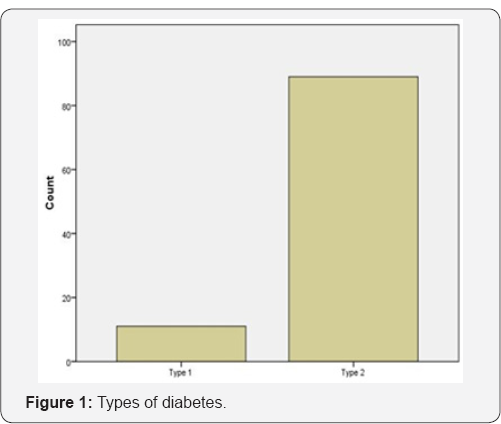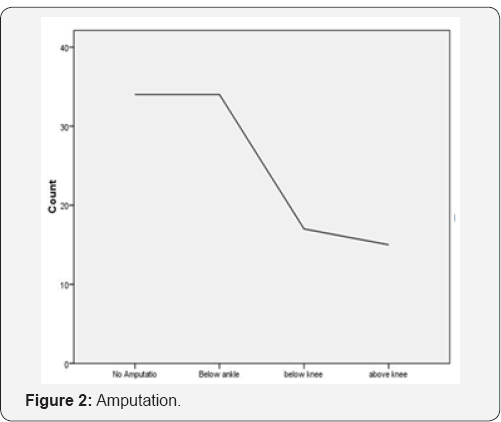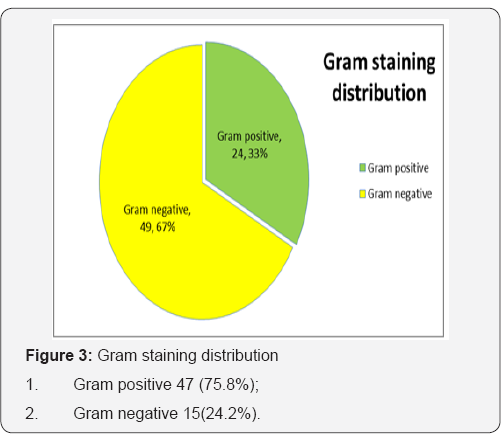Characterization of Most Common Bacterial Culture Isolates from Infected Diabetic Foot Tissue Specimens and Their Sensitivity to Antimicrobial Agents: A Survey of Patient Data from Three Tertiary Care Hospitals in Peshawar-Juniper-Publisher
Juniper Online Journal of Orthopedic & Orthoplastic Surgery
Introduction
A diabetic foot is a non-healing ulcer due to the presence of diabetes in a patient. [2]
The most important and serious foot complications in diabetes are:
a) Ulceration (an estimate shows lifetime incidence
of foot ulcers among people affected by diabetes is around 15-25%] “A
Diabetic foot ulcer (DFU] affects around 15% of all the people suffering
from diabetes along the course of their life and is a major factor in
predisposing amputations in almost 15% of all cases [3-6].
b) Neuropathic osteoarthropathy.
These are the significant risk factors for lower extremity amputation.
Administration of antimicrobial agents, to which they
are sensitive to, is very important part of the management of these
patients. “Of all the methods that are proposed for the prevention of
DFU, the only beneficial therapy in RCTs was foot temperature-guided
avoidance therapy “a meta-analysis shows [7].
Treating DFIs with broad spectrum antibiotics is
practiced worldwide; however, because of infections with resistant
organisms, treating with a narrow spectrum antibiotic may be more
appropriate, due to low resistance rates and high bacteriological and
clinical cure rates. The fact that antibiotic sensitivity changes with
time [8,9],
therefore knowledge of common bacteria involved and their current
sensitivity pattern will help us not only in providing the best initial
empirical therapy but also in preventing the emergence of resistance [10]
when taken properly and to prevent long term morbidity. Records of 2013
show that around 382 million people worldwide suffer from diabetes [11]. About 90% of these are type 2 [12,13]. International Diabetes Federation (IDF] in 2014 audited that diabetes resulted in 4.9 million deaths [14].
World Health Organization (WHO] in 2012 estimated that diabetes
resulted in 1.5 million deaths, what makes it the 8th leading cause of
death [15]. Modeling is used by IDF to estimate the deaths amounting to diabetes [16]. Low and middle-income countries amounted for around 80% deaths due to diabetes [17].
Within this backdrop we propose to study the most common organisms
responsible for Diabetic Foot Infection and their sensitivity to
antimicrobial agents for the prevention of sepsis/amputation by the
administration of empirical treatment.
Material and Methods
This study was carried out at the 3 major Tertiary
care hospitals of the province which receives patients from across the
province. Convenient sampling technique was used and the sample size was
calculated to be 100 using
WHO sample size calculator. Patients who were resident of KPK and were
admitted to KTH, HMC or LRH for diabetic foot treatment were included in
the study and those who refused to participate in the study, patients
with documented anatomical abnormalities of lower limbs (based on
history and past medical record] and those without a confirm diagnosis
of diabetes were excluded from the study.
Diabetes was defined as symptoms of diabetes plus
random blood sugar ≥ 11.1 mmol/ L or fasting blood sugar ≥ 7mmol/L
and/or HbA1c ≥ 6.5% [18].
A semi structured questionnaire was used for this purpose having
open-ended as well as close-ended questions. In most cases data was
collected by person to person interviews with respondents. Study was
conducted after approval from ethical & research committee.
Results
This section revolves around meaningful facts and
figures derived computational statistics of our research work. Our
sample size was 100 people belonging to different walks of life with
different occupations. 58 were males and 42 were females. Marital
status: 64 were married, 14 were single, 12 were divorced and 10 were
widowed. If we talk about their educational background then 37 were
uneducated, 26 studied up to primary, 17 were matriculate and 20 had
done higher education. Demographically, out of the 100 there were 24
from Peshawar region, 5 from DI Khan, 6 each from Chitral and Charsadda,
7 from Nowshera, 8 from Kohat, 9 from Bannu, 10 each from Sawabi and
Sawat, 15 from FATA.

Occupationally, out of 100 there were 8 who were
students, 8 others were self-employed, 10 were unemployed, 38 were
employed, 36 were house workers. 87 presented with Type 2 diabetes and
13 presented with Type 1diabetes 90 (Figure 1].
Amputation: 35 had no amputation, 35 with amputation below ankle, 16
with below knee amputation and 14 with above knee amputation (Figures 2 & 3].



a) The three most frequently found Aerobic bacteria E.coli (19%), Staph. Aureus (9%), Pseudomonas (7%) (Table 1).
b) The most frequently found Gram positive bacteria are Staph. Aureus (9%), MRSA (6%). The most common Gram negative bacteria are E.coli (19%), Pseudomonas(7%), and Proteus (4%).

c) Most effective drugs against Gram positive are
Cephalosporin's {Generation ll and lll (100%)}, Vancomycin (100%),
Imipenem (100%), piperacillin/Tazobactam (100%) (Table 2).i. Cefoperazone/Sulbactam (94.4%)
d) Most effective drugs against Gram negative are
Cefoperazone/Sulbactam (94.4%), Vancomycin (92.3%), Imipenem (89.4%),
and Piperacillin/Tazobactam (89.4%).
e) Most effective drugs against MRSA are Vancomycin (100%), Chloramphenicol (100%), Amikacin (100%), and Minocycline (100%).
f) Most effective drug against polymicrobial infection is Vancomycin (100%), Chloramphenicol (80%), and amikacin (50%).
Conclusion
a) Staph. Aureus and E.coli are the most common Gram positive and Gram negative organisms, respectively, in KPK.
b) Anaerobes are still the most common cause for this infection, although the prevalence is less.
c) These ulcers and infections may require use of
combined antimicrobial therapy for initial management, repeated dressing
and wound debridement may be required.
d) This study helps us to choose empirical treatment
for patients with diabetic foot infection and also in the management of
patient who comes with sepsis that is caused from diabetic foot.
Recommendations
From our study, we can concoct the following
recommendations which show us the most common organism involved in the
diabetic foot and help us in preventing the amputation and sepsis.
Since the most common organism appears to be E.coli and it is most sensitive to drugs such as;
i. Cefoperazone/Sulbactam (94.4%)
ii. Vancomycin (92.3%)
iii. Imipenem (89.4%)
iv. piperacillin/Tazobactam (89.4%)
a) Therefore, patients presenting with diabetic foot
should be directly put on empirical treatment, to prevent further damage
to the body and better recovery.
b) The patients should be educated to keep their feet clean and healthy.
c) The attendants of the patients should be advised to take proper care of their patient.
d) The patient should be compelled to check their limbs specially, lower extremities for any ulcers, wounds or cuts.
e) Good compliance to therapy will yield positive
results and would eradicate the complications before it causes further
damage to health.
To read more articles in Journal of
Orthopedic & Orthoplastic Surgery
To
Know More about Juniper Publishers click
on: https://juniperpublishers.com/



Comments
Post a Comment